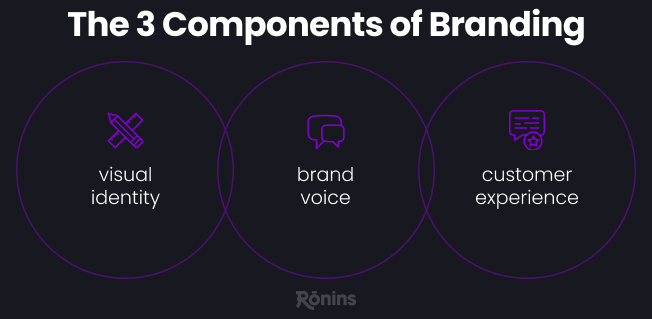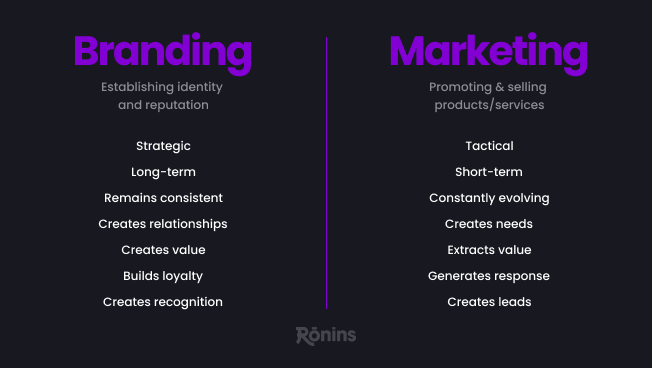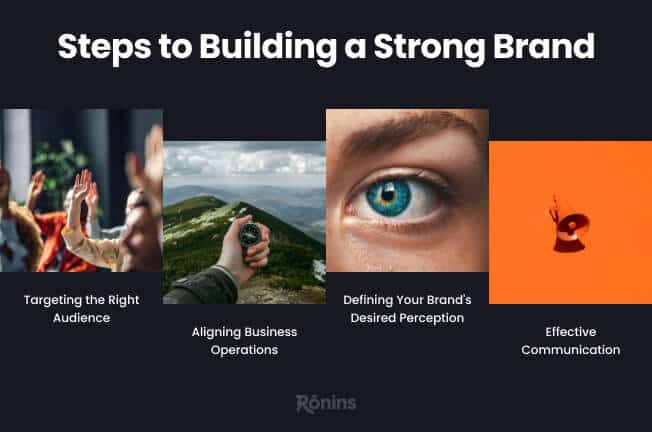
Why is Branding Important to Your Business?
Table of Contents
TLDR
Why is branding important? The essence of strong branding lies in its ability to create a memorable identity through visual elements, a distinctive voice, and exceptional customer experiences. It differentiates businesses in competitive markets, fosters customer loyalty, and facilitates the introduction of new products.
Effective branding is the foundation for marketing efforts, establishing a connection with customers beyond transactions, leading to long-term relationships and business growth.
Introduction
Have you ever wondered why certain brands become a part of our daily lives, almost as if by magic? The answer isn’t just about the products or services they offer but the power of impactful branding.
Branding, in essence, is the soul of your business made visible – it’s how you tell your story, evoke emotions, and connect with your audience on a level deeper than mere transactions.
We dive into the why and how of strategic brand development, unravelling its critical role in carving out a distinctive identity in the bustling marketplace and fostering lasting relationships with customers. Discover the strategic importance of branding and how it can transform the way your business is perceived, setting the stage for growth and success.
• • •
The core of branding
Good branding is essentially about crafting and managing the unique identity of a business or product in the marketplace. It’s a strategic process that involves developing a cohesive and consistent perception in the minds of consumers.
Branding goes beyond a memorable logo design or a catchy slogan; it encompasses the entire customer experience, from the visual identity and brand voice to the interactions people have with the brand.

The three key components of branding
01 Visual Identity
Visual identity forms the visual aspect of branding, including the logo design, colour palette, typography, and imagery. This component is crucial as it’s often the first point of contact between the brand and potential customers.
A strong visual identity helps make a brand recognisable and creates a memorable impression. It’s not just about aesthetics but also about visually conveying the brand’s values and personality.
For instance, a luxury brand might opt for a minimalistic design with a monochrome colour scheme to communicate elegance and sophistication.
02 Brand Voice
Brand voice represents the personality and emotion infused into a company’s communications. It encompasses everything from the language and tone used on the website, social media posts, and advertising to the style of customer service interactions.
A consistent brand voice helps build a connection with the audience by reflecting the brand’s personality and values. Whether it’s friendly and informal or professional and authoritative, the brand voice should be distinct and recognisable across all channels.
03 Overall Customer Experience
The overall customer experience is perhaps the most comprehensive aspect of branding. It includes every touchpoint a customer has with the brand, from browsing the website to purchasing and using the product or service and even after-sales support.
A positive brand experience strengthens loyalty and advocacy, as satisfied customers are more likely to return and recommend the brand to others. This component is about delivering on the brand’s promises and ensuring that all aspects of the brand—from product quality to customer service—are aligned with the brand’s values and expectations set through its visual identity and brand voice.

Branding vs. Marketing
While branding and marketing are closely related, they serve different purposes.
The branding process defines who you are as a company; it’s about establishing your identity, mission statement, values, and how you want to be perceived in the market. It’s the foundation upon which all marketing efforts are built.
Marketing, on the other hand, is about promoting and selling products or services. It involves a series of actions to communicate with the target audience, build relationships, and drive sales.
In essence, branding sets the stage for marketing. Without a strong brand foundation, marketing efforts might not be as effective because they lack a consistent message or identity to resonate with the audience. Branding attracts and maintains consumer loyalty, while marketing drives sales and market share. Together, they work hand-in-hand to build and sustain the business’s success in the marketplace.
• • •
Strategic Benefits of a Strong Business Brand
Strong branding offers strategic benefits that can significantly enhance a business’s position in the market, drive growth, and foster enduring client relationships. Here are some key strategic benefits of robust branding:

Recognition and Recall
Distinctive branding makes a business unforgettable. A well-crafted visual identity, including a memorable logo, unique colour scheme, and consistent typography, ensures that the brand captures attention and remains top of mind.
Recognition goes beyond mere visibility; it’s about creating a lasting impression that makes the brand the first thought when a customer thinks of a particular product or service category.
This immediate recall can be a decisive factor in purchase decisions, as consumers are more likely to choose brands they recognise and remember over those they don’t.
A Forbes study found that consistently using a colour palette for a brand’s logo and digital content can boost brand recognition by over 80%
Competitive Edge
In a crowded market, branding is a crucial tool for differentiation. It allows a business to stand out from the competition by highlighting what makes it unique. This could be anything from a unique selling proposition (USP), innovative products, superior service, or even the brand’s story and values.
Effective branding communicates these differentiators clearly and compellingly, making it easier for people to understand why they should choose one brand over another. A resonant brand can transform a generic offering into a preferred choice, creating a competitive edge that is difficult for the competition to replicate.
Loyalty
Branding doesn’t just attract prospects; it creates emotional connections that can foster long-term loyalty. Through consistent and positive brand experiences, people develop a sense of trust and affinity for the brand. This emotional investment means they are more likely to make repeat purchases, resist the lure of competitors, and become brand advocates.
Loyalty is beneficial for sustained revenue and lowers marketing costs over time, as retaining existing customers is typically less expensive than acquiring new ones. Additionally, loyal customers often become brand ambassadors, spreading word-of-mouth recommendations that can be more effective than traditional advertising.
43% of customers spend more on brands they are loyal to.
National Retail Federation
Brand Equity
Brand equity refers to the added value that influential branding brings to your products or services. This intangible asset stems from consumer perceptions, experiences, and associations with the brand.
High brand equity translates into a variety of tangible benefits, including the ability to charge premium prices, more favourable terms, and a higher likelihood of brand extension success. It also provides a degree of protection during economic downturns, as customers are more likely to stick with brands they know and trust.
Brand equity is critical to a business’s overall value, contributing to profitability, long-term sustainability, and growth potential.
Enhanced Credibility and Trust
A strong brand builds credibility with its audience, which in turn fosters trust. When a company consistently communicates its values and delivers on its promises, people are more likely to believe in the brand and feel confident in their choice. This trust is fundamental, especially in industries where the decision-making process is complex or highly emotional. Credibility can accelerate the sales cycle, as prospects are quicker to convert when they trust the brand.
According to Gensler, 94% of consumers would recommend a brand they are emotionally engaged with.
Easier Introduction of New Products
Brands with high equity find it easier to launch new offerings. Because the brand is already recognised and trusted, existing customers are more likely to try new offerings based on their positive experiences with the brand. This can reduce the risk associated with new product launches and increase the speed to market and adoption rates, providing a significant competitive advantage.
A Label Insight survey found over a third of consumers are more likely to try new products from brands they view as honest, authentic and transparent.
Attracting Talent
Strong branding not only attracts new customers but also top talent. When employer branding is viewed positively, it becomes a more desirable place to work. This can help attract and retain current employees, which is crucial for innovation and growth. Employees who feel proud to work for a well-regarded brand are likely to be more engaged, motivated, and loyal, further enhancing the brand’s internal and external reputation.
A strong brand can cut hiring and training costs by up to 50%
Better Negotiating Power
A cohesive brand can give a business better negotiating power with suppliers, retailers, and partners. High brand equity can lead to more favourable terms and conditions, as other companies often want to be associated with strong and reputable brands. This can result in cost savings, exclusive deals, or advantageous partnerships that enhance the brand’s market position and profitability.
Increased Financial Value
The cumulative effect of the aforementioned benefits is an overall increase in the company’s financial value. Strong brands often command a higher market valuation relative to their tangible assets. This is because a significant portion of a company’s value comes from intangible assets, like brand equity or brand value, which can influence future earnings potential. Companies with strong brands are more resilient to market fluctuations and competitive pressures, ensuring long-term sustainability and growth.
Social Impact
A well-defined brand that aligns with social causes or demonstrates corporate social responsibility can significantly influence societal norms and behaviours.
By leveraging their brand voice, companies can raise awareness, change perceptions, and drive action towards important issues. This contributes to the brand’s positive image and fosters a deeper connection with consumers who share similar values.
• • •
The strategic advantages of powerful branding are comprehensive, offering businesses a competitive advantage, enhanced market presence, and deeper connections.
The benefits of effective branding are extensive, from improving recognition and brand recall to fostering loyalty and enhancing brand equity to attracting top talent and increasing financial value. It supports a business’s ability to differentiate and compete and underpins its long-term growth and resilience.
Compelling branding is more than just visual design; it’s a holistic approach that builds trust, drives innovation, and amplifies impact, making it an indispensable element of successful business strategy.
• • •

Practical Steps to Building a Strong Brand
Building a strong, recognisable brand takes strategic planning and consistent effort. Here are some practical steps you can take to make your brand stand out:
Targeting the Right Audience
The foundation of effective branding is understanding who your target audience is. Identify who your ideal customers are demographically, psychographically, and behaviourally.
Understand their needs, pain points, and desires. With this knowledge, you can craft messaging and experiences that resonate with your audience and set your brand apart.
Defining Your Brand’s Desired Perception
What feelings and impressions do you want people to have when they encounter your brand? Align your brand image and identity with the perceptions you want to create. If you want your brand to be seen as innovative, forward-thinking, or high-end, ensure your visuals, tone, and offerings reflect that. Consistency is key.
Aligning Business Operations
Your branding efforts will fall flat if the customer experience doesn’t match the brand promise. Make sure every touchpoint and interaction, from your website user experience to customer service to product quality and packaging, delivers on your brand values. The brand must permeate all areas of your business.
Effective Communication
Ongoing communication with your audience reinforces what your brand stands for. Engage customers through social media, email marketing, and other channels to tell your brand story. Consistent, on-brand messaging keeps your business top-of-mind and strengthens brand affinity over time.
Following these steps requires strategy and commitment, but the payoff of a distinctive, memorable brand makes the effort worthwhile. By actively managing your brand, you can shape how people perceive and engage with your business.
• • •
Leveraging Brand Strategy for Business Growth
In addition to distinguishing your business in the marketplace, strong branding sets you up for growth in several key ways:
Introducing New Products
A solid brand makes expanding into new products or services easier. Customers are more likely to try offerings from a company they know and trust. Lean on your brand equity to reduce the risk and speed the adoption of innovations and new directions.
Generating Positive Reviews and Referrals
Satisfied customers are powerful brand advocates. A strong brand encourages word-of-mouth marketing as people share positive reviews, brand mentions and refer friends based on their brand affinity. This organic outreach is more convincing than ads.
Connecting with Customers on a Deeper Level
Branding is about more than surface-level messaging and logos. Leverage your brand story and values to make deeper emotional connections with customers. When people feel aligned with your brand, they are more loyal and engaged community members.
In today’s crowded marketplace, branding is a key competitive advantage. By diligently building and managing your brand, you can increase awareness, drive sales, enter new markets, and build an audience of brand evangelists. Treat your brand as a strategic asset and invest in its growth.
• • •
Common Pitfalls in Branding
While strong branding takes effort, the investment is well worth it. Be aware of these common branding mistakes to avoid:
Inconsistency
Every brand touchpoint must reinforce the same central message and experience. Don’t dilute or confuse your branding by being inconsistent across channels, communications, or customer journeys. Employing a branding agency that can define your brand guidelines will help set standards that are easy to follow. Clearly organise and distribute brand assets to internal teams to ensure efficient usage. Don’t overlook the value of properly packaging branding materials for internal implementation.
According to Forbes, consistent presentation of your brand, no matter where you are posting, can create a uniform message and promote brand identity, which can increase your revenue by up to 23%.
Neglecting Feedback
Your audience ultimately determines how your brand is perceived. Solicit input through surveys and reviews. Listen to customers and evolve your brand appropriately while retaining brand vision.
Copycatting Competitors
It’s tempting to model your brand after industry leaders, but mimicry makes it hard to stand out. Stay true to your unique brand identity rather than chasing trends.
Overcomplicating
Simple, memorable branding cuts through the noise. Don’t overthink names, logos, messages, etc. Opt for clarity over complexity.
Underinvesting in Brand Management
Branding strategies require ongoing maintenance. Don’t take your foot off the gas once initial brand assets are in place. Keep strengthening brand affinity through continuous, creative engagement.
With attentiveness and care, you can build a brand that resonates with your audience and propels your business success. Avoid common pitfalls through strategic, consistent branding practices.
• • •
Wrapping up
A strong, strategic brand is invaluable for business growth and longevity. By clearly defining your brand identity and image, targeting your audience, aligning your operations, and communicating consistently, you can build meaningful mindshare that attracts and retains customers.
While establishing a memorable brand takes work, the benefits are more than worth the investment. Branding sets you apart from competitors, fosters deeper connections beyond transactions, and lays the foundation for expansion. Whether you’re a new business, a small business or a large-scale enterprise, make branding a priority from day one.
Assess where your current brand stands in conveying your vision and resonating with customers. Look for gaps where branding can be strengthened. Craft a comprehensive branding strategy and maintain brand consistency across all touchpoints. Don’t let your brand power erode over time. You can build a brand that propels your business forward with focus and care.
• • •
FAQs
- Why is branding important? A successful brand has a unique identity for a business, encompassing visual elements, brand voice, and customer experience. It’s crucial for distinguishing a business in the market, fostering loyalty, and supporting the introduction of new products.
- How does visual language contribute to branding? Through logos, colours, and designs, your look and feel acts as a visual cue to a brand, making it recognisable and memorable.
- Can a brand voice impact customer perception? Yes, a brand’s voice reflects its personality and values through communication, significantly impacting how customers perceive and relate to the brand.
- What differentiates branding from marketing? Branding is the foundation that shapes a business’s identity and consumer perception, while marketing actively promotes the business’s products or services built upon that identity.
- How does strong branding benefit customer loyalty? Strong branding fosters loyalty by creating connections with people’s emotions, leading to long-term relationships and repeat business.
- What is brand strategy, and how does it support business growth? A clear brand strategy outlines how a business intends to build and shape its brand identity, including its visual identity, voice, and customer experience, to support its overall objectives and growth.





